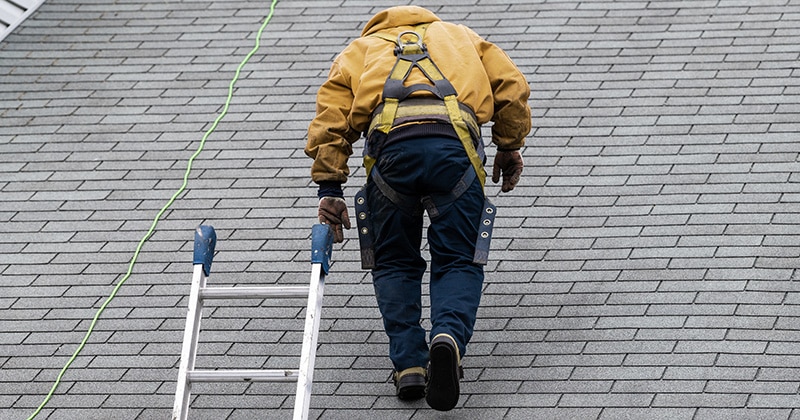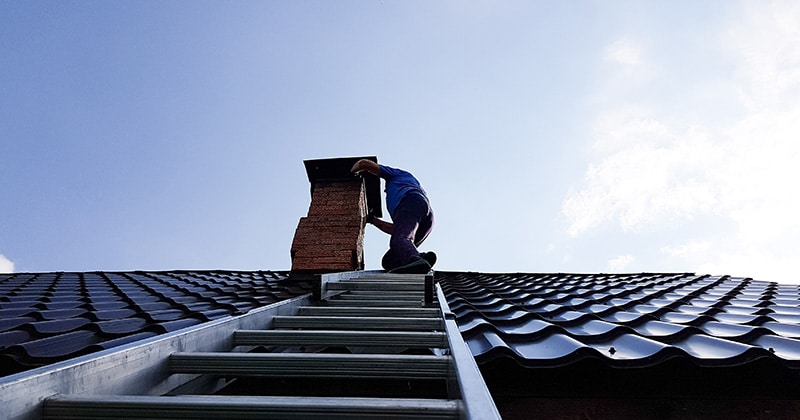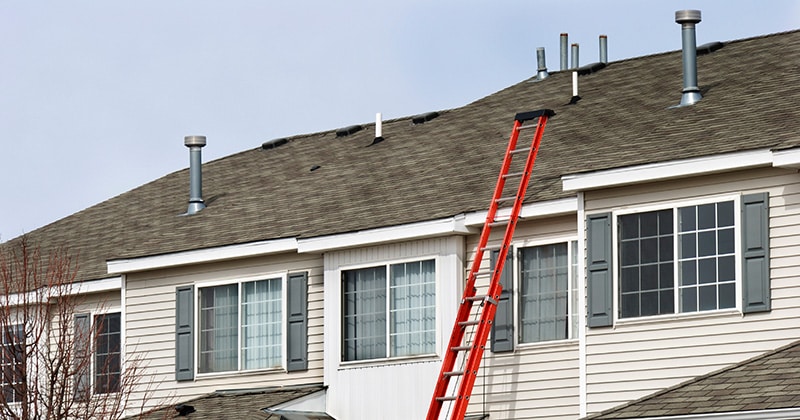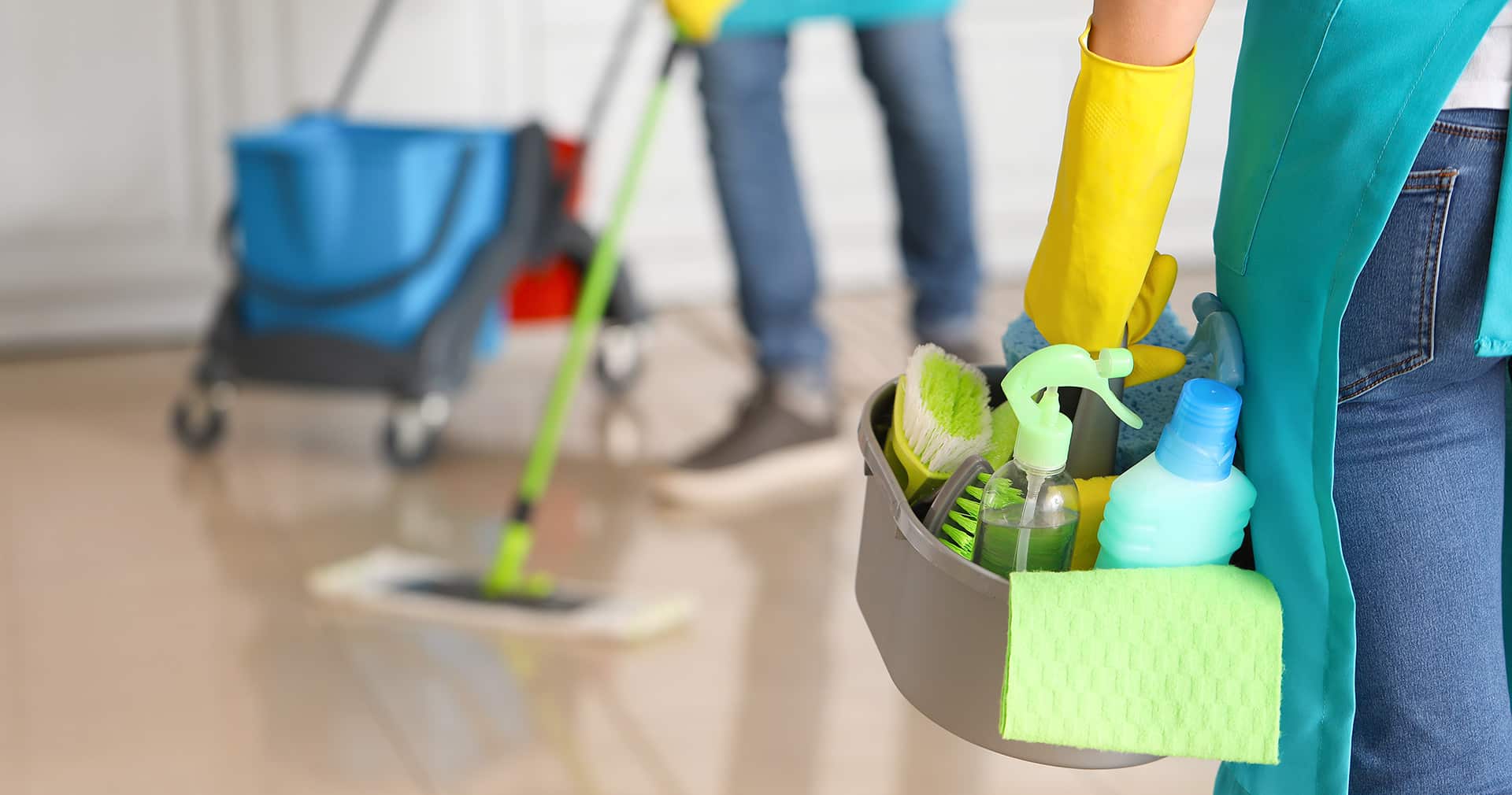The 6 Best Ladders for Professional Roof Work
You’ll get our recommendations for top roofing ladders. Use our checklist of things to consider when choosing a roof ladder. Our experts offer some tips you can use right away as you start shopping.

Staff Contributor
The right roof ladder can help make or break a roofing project for your business. Read on to learn why quality roof ladders are so essential.
You’ll get our recommendations for top roofing ladders. Use our checklist of things to consider when choosing a roof ladder. And our experts offer some tips you can use right away as you start shopping.
The Importance of Quality Roof Ladders
Having the right ladder is essential if you own a roofing business. When some roofing companies are just starting out, they may wait until they have a job to rent a ladder. But this can leave you high and dry if the right ladder isn’t available.
Therefore, it’s smart to invest in a quality roof ladder. In fact, you may want several for different types of jobs. Also, owning a couple of ladders means you can work with a bigger crew.
You can cover one large roof more quickly with multiple ladders. Or you can have staff out on several jobs simultaneously. Both affect your revenue and profitability.
Here are some other benefits of purchasing top-quality roof ladders for your business.
Ability to Handle More Difficult Jobs
The more ladders you own and the better their quality, the more you improve your ability to take on challenging roofing jobs. Some projects involve steep roofs or working at a greater-than-normal height. Others have unique roof configurations.
The more you can meet these challenges with the right equipment, the more competitive you can be in bidding for jobs. That puts you ahead of other roofers in your area who can’t do the work.
More Efficient Workflow
Having the best equipment possible helps your team work more efficiently, too. From your end, a smooth work process speeds up time to job completion.
The faster you can finish roofing jobs, the more you can fit into any given month. The more projects you can take, the more income you make. It’s that simple.
From the workers’ standpoint, efficiency is also valued. No one wants to work on jobs with subpar equipment that slows them down. If you’re like many businesses in the U.S. right now, you may have had trouble recruiting staff. So, you want to retain good workers and keep them happy.
Improved Worker Safety
Another way to improve roofing crew retention is to place a high emphasis on safety. Using top-quality roofing ladders is perhaps the best way to accomplish this.
Roofers definitely don’t want to work in dangerous conditions. You can read more below about how the right roofing ladders significantly improve safety on the job.
Fail to safeguard your crew? You could be looking at staff absences for accidents. You may also see more workers’ compensation claims or legal issues. Your company could be cited for OSHA violations, fined, or even shut down.

Professional Appearance for Your Company
You want to project the most professional and polished appearance for your business. Using the best equipment and showing you stress safety will help do this.
Why is this important? Existing clients will be more likely to recommend you to friends, family, and neighbors. And new clients will read positive reviews online and give you their business as well.
Did you know that 92% of consumers say they will use a local business if it has at least a four-star review? And customers will spend nearly a third more with companies that carry “excellent” reviews.
Key Considerations When Choosing a Roofing Ladder
Now that you know the benefits of buying a high-quality ladder, let’s look at how to choose one. Use these criteria, as well as the ones in the next section, to make a shopping checklist.
Which ladders tick the most boxes in these categories? Those are the ones you should put on your shortlist for purchase.
Ladder Height
Obviously, for roofers, ladder height is a key consideration. You typically can’t use the same kinds of ladders you might for general contracting and handyman jobs.
That means, in most cases, that self-supporting A-frame ladders are out of the question. These can only be used along the bottom of low roofs for tasks like finishing the roofline or attaching/repairing gutters.
You need extension ladders designed to go to the roofline and beyond for most roofing projects. These come in different lengths for various needs. Some may also include extras specifically for roofing, which we discuss below.
There are articulated (aka combination) ladders you may want to consider for flexibility at lower heights. These can be used as conventional step ladders. Or they can be converted to small extension ladders. It can be handy to have a couple of these ladders for jobs low to the ground or for doing off-season tasks like ice dam removal and gutter cleaning.
Remember, the last 3 feet or so (usually the last four rungs) of an extension ladder are unusable. You can’t step on the very top of the ladder because it’s unstable and therefore unsafe. So you need to subtract about a yard from the total length of any ladder you buy.
Extension ladders can be as long as 40 feet. Once you exceed that length, you need to consider bucket ladders (aka cherry pickers). These are what fire departments and utility companies use. Or you can use scaffolding, which is what professional painters and masons also sometimes use on properties of three stories or more.
Material and Fabrication
Ladders are typically made of one of three materials:
- Wood
- Aluminum
- Steel
Wood ladders tend to wear faster and may not have the weight capacity of metal ladders. There’s also the possibility of splinters as they age. But they’re better to use around electrical components, as long as they’re not wet. Wood is non-conductive of electricity, unlike metal.
While not common, fiberglass ladders are another choice. They’re recommended for working around charged electrical elements. These tend to be quite pricey and heavy. A happy medium may be an aluminum ladder with fiberglass side rails.
Aluminum is very lightweight and affordable. It withstands the elements well over time.
Steel is sturdier than aluminum, but it comes with a price—both in ease of use and to your bank account. That’s why they’re mostly used for fixed (permanent) ladders built into the side of a structure.
Steel ladders cost more, and they’re heavier to set up and move around. You want to balance their increased heft with any improved durability or weight capacity (see more below).
The ladder’s construction is also important. How are the rungs and side rails attached? Is the hardware reinforced? These components need to be as hardy as the rest of the ladder.
Weight Capacity
Ladders are duty rated by the amount of weight they can hold under rigorous testing. These ratings must be labeled on each ladder for safety purposes:
- Type IAA (Extra Heavy Duty, Rugged Use) – 375 pounds
- Type IA (Extra Heavy Duty, Industrial Use) – 300 pounds
- Type I (Heavy Duty, Industrial Use) – 250 pounds
- Type II (Medium Duty, Commercial Use) – 225 pounds
- Type III (Light Duty, Household Use) – 200 pounds
Never overload a ladder with more weight than it’s designed to handle. Also, remember that this total weight includes the user, fully clothed in work gear. And it includes any equipment the user is hauling, like tools or shingle bundles.
Safety Features
Some ladder models come with safety features that make them more secure for workers. These include:
- Wider rungs with more surface area
- Slip-proof serrated rung traction
- Base/foot stabilizers (footpads or caps)
- Adjustable angle base stabilizers
- Wings for increased stability at the top or bottom
- Hoisting wheel to avoid manually hauling materials
Other safety features may be separate, but they’re definitely worth investing in:
- Roof hooks to secure the ladder at the roofline or roof peak
- Ladder leashes to prevent the ladder from slipping sideways
- Base stabilizer extensions for uneven ground (or multi-leveling tool)
- Ladder stabilizers to prevent slipping or damage around gutters
- Ladder grips for safe worker mounting and dismounting of the ladder
Transport and Storage
Any ladder you choose needs to fit in or on your work van or truck. Most professional roofers have side support hooks or a rack for transporting ladders to and from jobs.
When you’re not using your ladder, where will it be stored? The more compact it is, the easier it will be to keep in your garage, office, or storage unit.
Convenient Extras
Some ladders come with nice perks that make them easier to use. These include hooks for hanging gear or tools. They may have a detachable platform for items you’re using.
There are also collapsible ladders on the market. You may find these convenient for easy moving and storage.
Budget
Of course, your company’s budget will play a part in determining which ladders are viable contenders. In general, try to get the minimum number of best quality ladders you can afford. This is better than buying a lot of lesser-quality ladders.
If the top-quality ladders seem expensive, can you work extra jobs to pay for them? Other ways to get good ladders for a more reasonable price include:
- Buying at the end of the warm weather season
- Purchasing last year’s models
- Looking for open box or returned items with no defects
- Putting in a bulk order for multiple ladders for a discount
You could also try financing your ladders. If you’re a new roofing business, you might also be able to get a loan for your ladders as part of your startup costs.
Top Features to Look for in a Roofing Ladder
Given the list above, what are some of the most important things to look for with a roof ladder? Here are a few additional considerations.
Adjustable Height
Many extension ladders have some sort of telescoping mechanism. This makes their length adjustable. The largest ladders often come in two parts: the base or bed (bottom) and the fly. The fly is the part that slides upward to make the ladder longer.
As mentioned earlier, there are also some collapsible ladders. These have multiple sections that slide together into a small space, similar to the tubes in a vacuum cleaner attachment.
Features Specifically for Roofing
Also discussed earlier are safety features. These make certain ladders appropriate for roofing jobs. These elements take a regular extension ladder that, say, painters might like and turn it into a more efficient ladder for roofers.
It’s well worth looking for these features in your ladders. It’s like the difference between a regular tape measure and a digital one for contractors or real estate agents.
And naturally, the safety component is huge. Roofing has the second-highest fatality rate of all workplaces in the U.S. Anything that improves workplace safety for roofers should be a major consideration for you.
Easy Set-Up and Take-Down
When buying roofing ladders, you must constantly balance ease of use with stability. Time is money. So, you need ladders that are quick to set up, move, and take down.
Never sacrifice safety or durability for convenience. But do you really need all your ladders to have Type IAA duty ratings?
Durability and Reliability
Durability doesn’t just relate to their stability in the moment. You also want ladders that will last for years. This means they must take wear and tear as well as exposure to weather.

The 6 Best Ladders for Professional Roof Work
We used all the criteria in the previous two sections to make our list of the best roof ladders for professionals. Our experts tried to find that sweet spot between cost-effectiveness and quality for you. And we understand not all roofing jobs are the same, so we picked a range of sizes too.
Little Giant Velocity with Wheels
This is a versatile ladder for professionals who do roof work and other tasks. The M26 model extends to 26 feet and is rated for 300 pounds.
But what users love about this ladder is its many configurations and functions.
You can certainly use the Velocity as an extension ladder. However, it also converts to one large A-frame ladder. Or you can separate the pieces into two smaller A-frame ladders to make trestles, with a plank between them for a work platform.
Wheels at the base make movement easy. An option for ratcheting levelers lets you use the ladder on uneven ground or stairs.
What’s not to like about the Little Giant Velocity? It may be hard for one person to use the ladder alone. And the price tag gets up into big ladder levels—you’re paying for versatility here.
DeWalt 12-Foot Fiberglass Stepladder
If you think about where you’re most likely to encounter electrical lines as a roofer, it’s not usually up high. Rather, you’ll often find electrical hazards at the roofline level, where power enters the home.
Therefore, your step ladder used at this height may need to be of fiberglass to reduce electrical conduction. This DeWalt model is a fantastic option.
Rated at 300 pounds for each side of the ladder, this one can be used by two people simultaneously. Magnet and tool slots at the top offer convenience. A wide step surface provides greater comfort and safety than many step ladders.
Your sole negative here is the height. This ladder comes in 8- and 10-foot versions as well, but they may all be a bit short for higher rooflines.
Werner 1524-2 Aluminum D-Rung Extension Ladder
Werner ladders have a sturdy D-rung construction. They always top the lists of ladders for professional roofers. Able to hold 300 pounds and extend to 24 feet, this is a solid option for many one-story roofing jobs.
For budget-conscious roofers, this ladder has even greater appeal. You can separate the base and fly sections of the ladder to create two shorter ladders.
Users also like the slip-resistant rungs and the end caps that prevent marring the homeowner’s siding or gutters. Shoes at the base are adjustable and can be locked in place at different angles.
The only negative of this ladder is the weight. Even though it’s made of aluminum, it weighs in at 45 pounds. You may want two people to set it up, take it down, and load it.
Werner GlideSafe 40-Foot Fiberglass Extension Ladder
Want maximum height plus the non-conductive protection of fiberglass? This model consistently gets high ratings from professional users.
Check out these features:
- 300-pound load capacity
- Easier to raise with Lift Assist technology
- Speed control lowering
- Dual locking system for the fly
- Twist-proof rungs with slip resistance
- Mar-resistant molded end caps
While a few customers had difficulty with the release lever (plastic vs. metal), the reviews are overwhelmingly positive.
“This is an excellent and easy to maneuver extension ladder,” said one user. “It has lots of useful features not found in your typical extension ladder; it’s easier to raise and lower the ladder, locks in place better, and feels very sturdy!”
At 98 pounds, though, this ladder is best used by two people.
Ohuhu Aluminum Telescoping Ladder
Users like this ladder most because of its telescoping function that lets you reduce 12.5 feet of ladder into 18.9 inches for storage or transport. It’s a good option for smaller jobs where you don’t need a ton of height, but it’s a little longer than most stepladders.
Push-button technology lets you expand or collapse the ladder at will. With a weight of 28 pounds, it’s easy to move around as needed. This ladder is duty rated for 250 pounds.
The downside of this model? You have to push buttons for every rung you add. This can slow you down on set-up and take-down at job sites.
Badger Companies 6-Foot Chicken Ladder
A chicken ladder isn’t a regular ladder to reach a roof. Instead, it’s a ladder to attach to the surface when workers need to access hard-to-reach spots once they are already on the roof. They’re also used on very steep pitches.
This chicken ladder extends to 24 feet and has a capacity of 250 pounds. It features:
- Hand-welded steel rungs
- Powder-coated surface
- Yellow color for visibility
This ladder meets or exceeds the Occupational Safety and Health Administration (OSHA) and American National Standards Institute (ANSI) standards. But at over $100, it can be hard to add yet another ladder to your list, especially one with such limited use.
Also, the use of chicken ladders requires special safety training. A safety harness should be worn, which adds to your expense.

Top Takeaway Tips for Selecting a Roofing Ladder
-
When budgeting for roofing ladders, consider your return on investment (ROI). Crunch the numbers to see how many jobs you need to do before the ladders pay for themselves. It may not be as many as you think.
-
Always check out the reputation of any ladder company you’re buying from, and read customer reviews. How are they about returns and replacements? Is customer service responsive? What are their warranties like?
-
Plan to hold safety training sessions whenever you put a new ladder in rotation with your crew. Review how the ladder works and how to use it safely. Pay particular attention to securing the base and the upper part of the ladder.
-
Do you already have workers using ladders right now? Be sure to ask them what they would like to see in new models. They may request some features you hadn’t thought of for safety or efficiency.
Beckie likes words! Whether she’s creating content or working on the shortest of short stories, she’s always thinking about craft. In her downtime, she contributes to her mission of filling up her camera roll with as many photos of her cats as possible. They hate it.


